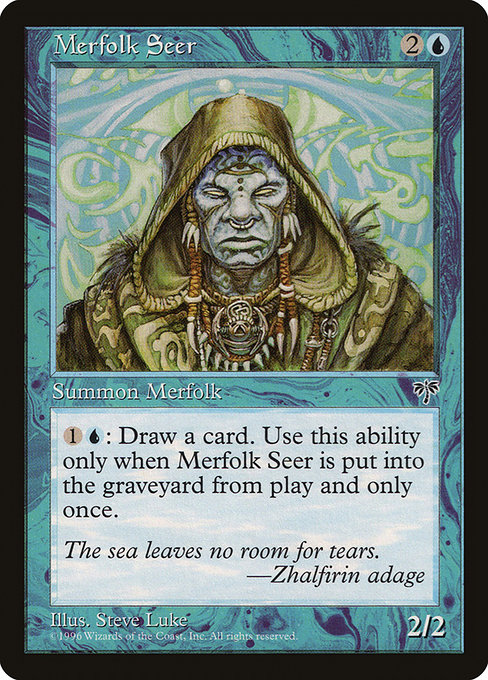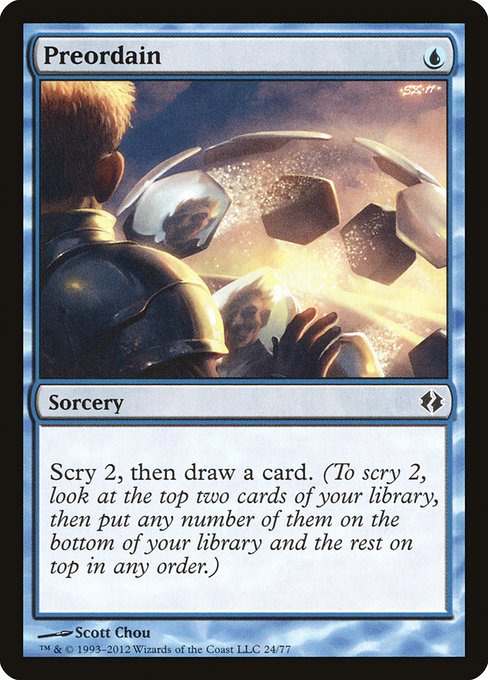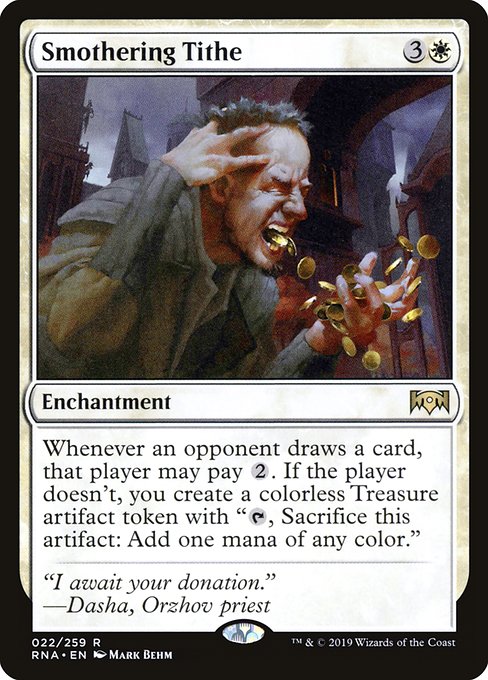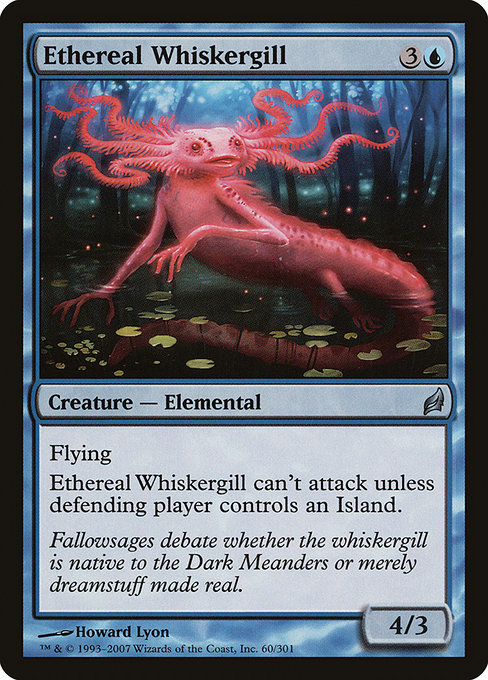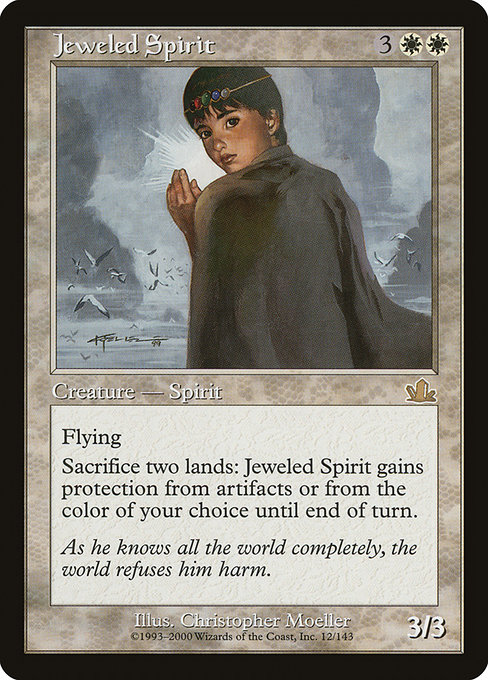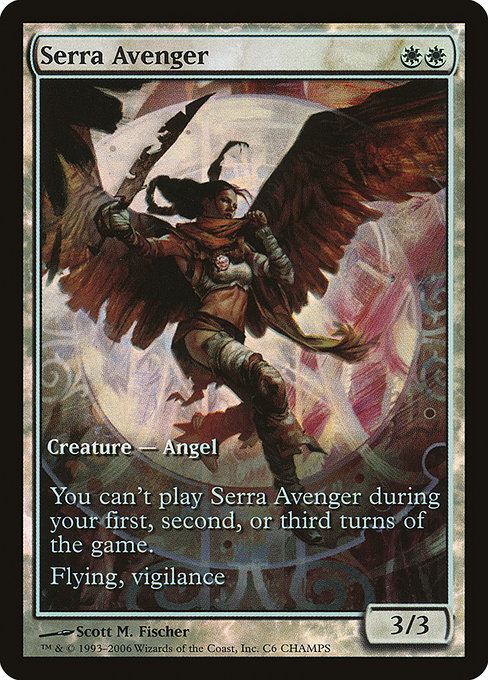
Serra Avenger

Full Analysis
Generated on 2025-06-28T22:23:42.932949 • Legacy FormatThe Angelic Sentinel of the Late Game: An Analysis of Serra Avenger
The Versatile and Impactful Serra Avenger
Serra Avenger stands as a powerhouse in the world of Magic: The Gathering, commanding respect and attention from players across various formats. As a 3/3 creature with the coveted combination of flying and vigilance, this angelic guardian offers a formidable late-game presence that can quickly turn the tide of a match. However, the Avenger's unique casting restriction, which prevents it from being played during the first three turns, forces deckbuilders and strategists to carefully navigate the game's early stages before unleashing this potent finisher.
Mechanics and Interactions: Balancing Power and Restriction
At its core, the Serra Avenger is a 3/3 flyer with vigilance, a configuration that grants it significant value in the late game. The key aspect that defines the Avenger, however, is its unique casting restriction: it cannot be cast during the first three turns of the game. This delayed entry serves as a crucial balancing factor, ensuring the Avenger's power is not overly oppressive in the game's opening stages.
The inability to cast the Avenger on turns 1-3 has several important implications. First, it prevents the Avenger from becoming a dominant early-game threat, allowing opponents to establish their own strategies and tempo without the immediate pressure of this powerful finisher. This restriction also means the Avenger cannot be used to accelerate one's game plan or tempo through plays like turn 2 Mox Pearl into turn 3 Avenger, a common strategy seen with other powerful 4-mana creatures.
Notably, the Avenger's casting restriction is based on the player's turns, not the actual turns of the game. This means that if a player's turn is somehow skipped or manipulated, the Avenger can still be cast on that "turn." For example, if a player uses Time Walk to take an additional turn, they would be able to cast the Avenger on that extra turn, even if it's technically the fourth turn of the game. This interaction introduces an intriguing layer of complexity and potential for creative deckbuilding.
The Avenger's flying and vigilance abilities are what truly elevate it as a formidable threat. Flying provides evasion, allowing the Avenger to bypass ground-based blockers and attack unimpeded. Vigilance, on the other hand, enables the Avenger to attack while still defending, making it a versatile creature that can dominate both the offensive and defensive aspects of the game.
Strategic Uses, Combos, and Synergies: Maximizing the Avenger's Potential
The strategic value of the Serra Avenger lies in its ability to transform the tide of a game when cast at the right moment. In white-based midrange and control strategies, the Avenger serves as a powerful late-game finisher that can close out games quickly, providing a resilient and evasive threat that demands immediate attention from the opponent.
One of the Avenger's key strengths is its synergy with other white-based strategies and cards. For example, in decks running Elspeth, Sun's Champion, the Avenger can provide an additional source of lifelink to further bolster the player's life total and stabilize the board. Similarly, the Avenger pairs well with Archangel of Thune, as the Avenger's vigilance allows it to attack and still block, while the Archangel's ability can lead to exponential growth for the Avenger.
In control-oriented strategies, the Avenger can be used as a game-ending threat that forces the opponent to find an immediate answer. By holding up mana for counterspells or removal spells on the earlier turns, the player can then safely deploy the Avenger on turn 4 or later, pressuring the opponent's life total and potentially overwhelming their defenses. The Avenger's vigilance further enhances this synergy, allowing it to serve as a defensive creature while also threatening the opponent.
The Avenger's delayed entry can also be leveraged in various combo scenarios. For example, in a deck featuring Oblivion Ring or Banishing Light, the player can use these enchantments to temporarily remove problematic threats on earlier turns, then cast the Avenger on a later turn to provide a persistent threat that the opponent must address.
Additionally, the Avenger's casting restriction can be mitigated or overcome through the use of cards like Suspend or Savor the Moment. By suspending the Avenger or manipulating the turn sequence, players can find creative ways to deploy the Avenger earlier than the standard turn 4 or later, opening up new strategic avenues and potentially catching opponents off guard.
Deckbuilding Roles and Archetypes: Finding the Avenger's Home
The Serra Avenger finds its natural home in white-based midrange and control strategies, where its powerful late-game presence can help secure victory. In these archetypes, the Avenger serves as a key finisher that can overwhelm the opponent's defenses and close out the game.
In midrange decks, the Avenger complements a strategy that aims to establish a solid board presence and tempo advantage in the early-to-mid game, then transition into a powerful late-game threat. Cards like Elspeth, Sun's Champion, Archangel of Thune, and Gideon, Ally of Zendikar can work in synergy with the Avenger, creating a formidable suite of white-based threats that can grind out opponents and eventually deliver the decisive blow.
Control decks, on the other hand, can utilize the Avenger as a game-ending payoff for their defensive gameplan. By using removal spells, counterspells, and other control elements to survive the early game, the control player can then safely deploy the Avenger on a later turn, forcing the opponent to find an immediate answer or risk losing the game. The Avenger's resilience and evasion make it a challenging threat to deal with, particularly in the late stages of the game, where its ability to attack while still maintaining a defensive presence on the board can be invaluable.
It's worth noting that the Avenger's restricted casting cost can limit its viability in certain formats or metagames. In more aggressive or tempo-oriented environments, the Avenger's delayed entry may make it too slow to be an effective inclusion. However, in formats where the game plan is focused on the mid-to-late game, the Avenger can shine as a powerful finisher that can close out games.
Format Viability and Competitive Context: Adapting to the Metagame
The presence and performance of the Serra Avenger in various Magic formats can vary greatly, depending on the overall metagame and the specific strategies that are prevalent.
In Standard, the Avenger has seen sporadic inclusion in white-based midrange or control decks, particularly when the format's tempo and aggression levels allow for a slower, more grindy game plan. For example, during the Theros block, the Avenger was a key piece in Selesnya-based midrange strategies, where it complemented cards like Voice of Resurgence and Fleecemane Lion. However, in more aggressive Standard environments, the Avenger's delayed entry can make it too slow to be a consistent inclusion.
In Modern, the Avenger has found a more stable home in certain white-based control and midrange archetypes. Decks like Azorius Control and Bant Midrange have utilized the Avenger as a late-game finisher, leveraging its resilience and evasion to close out games. The Modern format's overall slower pace and emphasis on card advantage and interaction make the Avenger a viable option in these strategies.
In Legacy and Vintage, the Avenger's inclusion is more niche, as the format's high-powered nature and focus on fast, combo-oriented strategies often leave little room for the Avenger's delayed entry. However, in certain white-based control or midrange decks, the Avenger can still serve as a powerful finisher, particularly in the face of slower, grindy matchups.
It's worth noting that the Avenger's casting restriction can lead to interesting rules interactions and considerations. For example, if a player's turn is skipped or manipulated through effects like Time Walk, the Avenger can be cast on that "turn," despite it being the fourth turn of the game. Similarly, the Avenger's interaction with suspend and other effects that can circumvent its casting restriction can lead to unique gameplay situations that require a deep understanding of the game's mechanics.
Art, Flavor, and Historical Context: The Avenger's Narrative
The artwork for the Serra Avenger depicts a majestic, winged angel descending from the sky, sword drawn and ready for battle. The image conveys a sense of power, grace, and divine intervention, fitting the Avenger's role as a game-changing late-game threat.
Thematically, the Serra Avenger draws inspiration from the long-standing tradition of angelic creatures in Magic: The Gathering. As part of the white color pie, angels are often associated with themes of protection, justice, and divine retribution – characteristics that the Avenger embodies through its combination of vigilance, evasion, and resilience.
The Avenger's name and flavor text, "Daring the unworthy to approach," further reinforces its role as a guardian and sentinel, standing watch over the battlefield and challenging those who would dare to test its might. This evocative flavor contributes to the Avenger's overall appeal and sense of narrative within the game.
Historically, the Serra Avenger has appeared in several Magic expansions, including Avacyn Restored, Commander 2013, and Modern Horizons 2. Its inclusion in these sets highlights the card's enduring popularity and status as a powerful and iconic white creature within the game.
The Avenger's design and implementation also reflect the ongoing balancing act that Wizards of the Coast must perform when introducing powerful late-game threats. The Avenger's delayed entry serves as a key limitation that helps prevent it from dominating the early game, while still allowing it to shine as a game-defining force in the later stages of a match.
Conclusion: The Avenger's Enduring Legacy
The Serra Avenger is a versatile and impactful card that occupies a unique space within the white color identity of Magic: The Gathering. Its delayed entry, combined with a powerful set of abilities, forces players to carefully manage the game's tempo and plan their plays accordingly. While the Avenger's restricted casting cost can limit its viability in certain formats, it finds a natural home in white-based midrange and control strategies, where its resilience, evasion, and late-game punch can help secure victories.
Through creative deckbuilding, synergistic interactions, and an understanding of the Avenger's rules interactions, players can maximize the card's potential and leverage it as a game-defining threat. The Avenger's enduring popularity and status as an iconic white creature further cement its place in the pantheon of powerful and memorable Magic cards, solidifying its legacy as the Angelic Sentinel of the Late Game.
